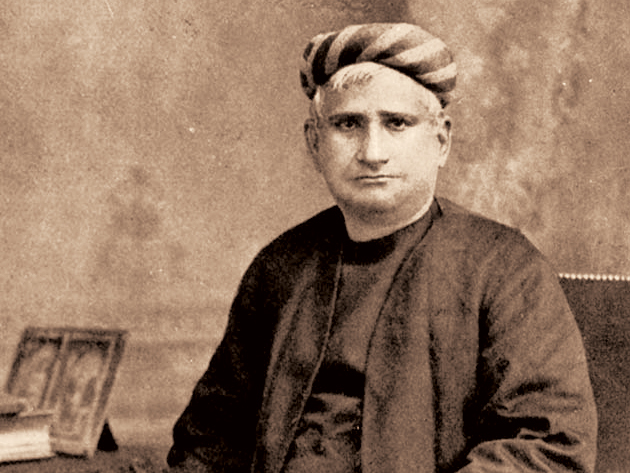Three decades ago, at the Nehru Memorial Museum and Library in New Delhi, I was poring over the microfilms of Swadesamitran, the earliest Tamil daily, when I chanced upon a book advertisement. It was for a detective novel titled Parimala. In formulaic terms, it promised a great read filled with interesting turns. What caught my eye was that the advertisement claimed that it was endorsed by Subramania Bharati (1882-1921), the great Tamil poet. Now Bharati was not known to have commented on any novel, much less recommend it. Curious, I looked for Parimala in libraries across the world.
Two decades later, I traced the first edition of Parimala (1907) in the mecca of Indian historians — the British Library in London. I collected the book at the issue desk and skimmed it eagerly. The title page stated that it was a novel by Bankim Chandra Chatterjee, translated into Tamil by one T.V. Krishnaswamy Sastri and edited by S.G. Ramanujalu Naidu (1886-1935), the doyen of Tamil journalism. In the editorial preface, Naidu stated that the novel had been translated by the subeditor of his monthly, Prajanukulan, and that apart from revising the translation, he had, “in keeping with the needs of the times”, woven in two Swadeshi poems by Bharati into the novel. If such interpolation would seem strange, more surprises were in store.
Within months of the publication of Parimala, in January 1908, a full Tamil translation of Anandamath appeared. The translator was Mahesha Kumar Sharma, a scholar well versed in Tamil, Telugu, Bengali, Hindi, Sanskrit and English, who had at various times been associated with the Brahmo Samaj, Arya Samaj, the Ramakrishna Mission and the Theosophical Society. Apart from translating into Tamil Ashwini Kumar Dutt’s Bhakti Yoga, in later years he translated Bankim’s novel, Chandrasekhar, as well. Of further interest to us here is that he too, like Naidu, was a friend of Bharati.
In the introduction to the book, Sharma provided an overview of how Bankim’s works had been translated into various Indian languages, especially Tamil. Stating that Durgeshnandini had been translated into Tamil earlier, he added that at the invitation of a friend, he had himself translated Bankim’s short stories such as “Radharani” and “Hiranmayi”. He noted the recent publication of Parimala, but added that Bankim was not known to have written a novel with such a title, and wondered if the title had been changed. To make the story curiouser, on the same page that this observation is made, in a footnote, he thanked Bharati for providing a beautiful verse translation of “Bande Mataram”, the song to be used in the book.
Bharati could not therefore have been unaware of the doubt cast by Sharma on the authenticity of Parimala.
To add a further knot to the mystery, in a brilliant portrait of Bharati that Naidu wrote in 1928, seven years after his death, he noted that Bharati had personally read the proofs of Parimala and suggested many revisions when he was down with malaria as the book was in the press. Naidu also noted that Bharati carried a review running into “six columns” in his weekly, India. Given that the issues of India from mid-1907 to mid-1908 are completely lost, there is no way to verify Naidu’s statement. However, from the latter part of 1908, India carried a long advertisement for Parimala for weeks on end.
More than 10 years later, in 1920, a second edition of Parimala was published, and it is the advertisement of this edition that I alluded to at the beginning. Bharati was subeditor of Swadesamitran at this time, after his ten-year political exile in Pondicherry. Bharati could not have possibly missed the advertisement, which claimed his endorsement.
So the question remains. Was Bharati aware of the doubts cast on the authenticity of Parimala? What was his response? Did he, in fact, believe that the Tamil Parimala was Bankim’s work? We may never have the answers to these questions.
Perhaps a quick summary of the novel’s plot may help to probe this mystery further.
Vimala, the daughter of Ramkumar, is betrothed to Devidas. The orphaned Parimala is Ramkumar’s niece. On the day of her marriage, Vimala disappears, and a bloodstained knife is found on her bed. Ramkumar swears to avenge her death, and hires a private detective, Sanjiv Kumar Mukhopadhyaya, to unravel the mystery. Meanwhile, Devidas’s father, Ganshyam Mukhopadhyaya, who also happens to be the father-in-law of Ramkumar, has left a will bequeathing all his properties to Devidas and his grandchildren. He suspects that Devidas and Parimala may be having an illicit affair. It emerges that the bloodstained knife is Ramkumar’s, and a letter confirms this conclusion. A severed hand is found in the lotus pond, as well as the dead body of Ramkumar. Sanjiv Kumar vows to trace Vimala, and he gets into a fight with Devidas but ultimately they join hands. Now it is the turn of Devidas to suspect his uncle and his son, and wonders if Parimala, too, may be involved. It is at this point that, out of the blue, for no reason, two patriotic songs written by Bharati appear in the text. Later Sanjiv Kumar finds a corpse, and now his suspicion turns towards Parimala. At this point, Devidas is killed. Now, Parimala’s twin sister, believed to be long dead, turns up. In fact, she is the culprit. Vimala had not actually died. In the climax, the detective marries Parimala.
All this and more is packed into 127 pages. If the readers think I am crazy, they are invited to read the original!
It stretches one’s credulity to believe that Bankim would have penned such a narrative. And to think that such luminaries as Subramania Bharati and Ramanujalu Naidu should be involved in this fake! It is for historians of print culture in colonial India to understand such curiosities.










